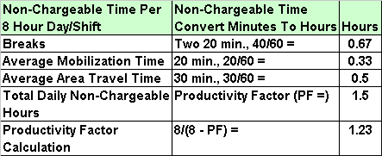
Profitable Pricing Strategies To Win The Business
The main objective when pricing service agreements is to determine where the prospect is relative to price in comparison to the competition's pricing and quality of delivery. Below are the three pricing situations and strategies that all commercial sales situations fall into.
Situation: You Have No Competition Due To:
Strategies:
Situation: You Are Up Against Good Competition Due To:
Strategies:
Situation: You Are Up Against Weak Competition Due To:
Strategies:
Gathering Data To Develop An Estimate
Once you have determined the strategy you will use, you now need to gather additional scope of work and company pricing information in order to calculate the right service agreement price. The following data are required in order to develop profitable commercial service agreement estimates:1. Identify the distance from point of labor dispatch to job location.
2. Survey the facility to obtain a list of HVACR equipment including quantity, size, and location of each.
3. Determine the scope of work for each piece of equipment.
4. Identify any difficult facility or equipment access requirements for each piece of equipment.
5. Identify your maintenance labor cost rates.
6. Identify your daily labor productivity factor based on non-chargeable time.
7. Identify your truck and travel rates.
8. Identity your cost markup or gross profit margin rates.
9. Obtain equipment labor and material estimating tables.
10. Obtain component repair and replace liability adjustment factors for full labor or full service agreements only.
In the previous article in this series you learned how to conduct an on-site equipment and system survey to collect items 1 through 4. The following will show you how to ascertain items 5 through 7, your maintenance labor costs by category, daily labor productivity factors, and truck/travel rates.
Identifying Your Maintenance Labor Cost Rates
Most contractors use a cost-based service agreement estimate by estimating agreement costs and then applying their cost plus markup or gross profit margin to the entire service agreement cost. Some contractors use fully burdened labor costs that include non-chargeable time and other overhead, truck charges, travel, benefits, and insurance. Other contractors use direct labor costs only and capture overhead and burden in their margins. We recommend that you use direct labor costs which include benefits and insurance only to estimate the actual labor costs and to escalating all agreement hours by the average or known productivity factor for a specific agreement.Calculating Your Labor Productivity Factor
The amount of time it takes to service equipment is easily found from the equipment manufacturer or from widely accepted HVAC estimating programs like Building Services Institute's AccuPro estimating program available online at www.bsig.net. However, if it takes one hour to properly tune and maintain a 10-ton packaged rooftop unit, you simply can't estimate costs based on one hour to do the job. You need to add time to get the technician there and for normal workday breaks. Most technicians are only seven hours productive even if they do not leave the shop due to breaks and mobilization as illustrated below. Naturally, you have to also subtract travel to get to the job.
This means that if you require an hour each for 10 packaged rooftop unit tuning inspections you would need to multiply as follows - 10 units x 1 hour tuning labor x 1.23 = 12.3 hours - due to daily non-productive hours.
Calculating Truck And Travel Costs
Most contractors use a per trip charge for time and material work. These tend to be average per trip labor and truck costs within their territories. Some use this method while using zones for different distances from the home office (e.g., 15 miles from office (Zone A) = 1/2-hour round trip plus truck charge = $38 cost charge). This per trip method works well when the maintenance technician is not at the location for very long. However, when estimating agreements using this method for service agreements where the technician will be dispatched for inspections over a several day period, using an average per trip charge may result in overinflated truck costs versus a competitor who uses a true cost method as shown below.
The true cost method uses an actual per hour truck cost to capture fixed truck costs and a per mile cost to capture the variable fuel and maintenance costs. To calculate the hourly truck and the per mile fuel and maintenance costs you can use the model illustration here.
The AccuPro estimating program provides you with either method of calculating truck and travel costs. All you need to do is to select which method you prefer and then enter your charges or costs in the appropriate category.
Gross Profit Margin Versus Markup
Most contractors use the gross profit margin pricing method (e.g., 50 percent gross profit margin, which is equal to cost plus 100 percent). The pricing calculation using gross profit margin is shown below:Cost/(1 - gross profit margin) = Sell Price or $100 cost/(1 - .5) = $200 Sell Price
Multi-Year Price Escalation Rate
Today contractors typically offer service agreement in three- or five-year terms to lock in clients for longer periods and on renewals to increase service base retention. The AccuPro estimating program produces an annual price for each of five years. You need to enter what you feel is the escalation rate for years two through five. Most contractors use industrial price index versus consumer price index. Your equipment vendors are excellent sources to obtain this information.Wendell Bedell is president of Building Services Institute Inc. For information about Building Services Institute's residential and commercial business development education series, marketing methods, pricing software, Residential Thrust or Commercial Thrust membership program, and PowerMax coaching/mentoring support services, visit www.bsig.net or call 800-240-2823. Bedell can be reached directly at 866-557-1611.
Publication date: 05/16/2005





